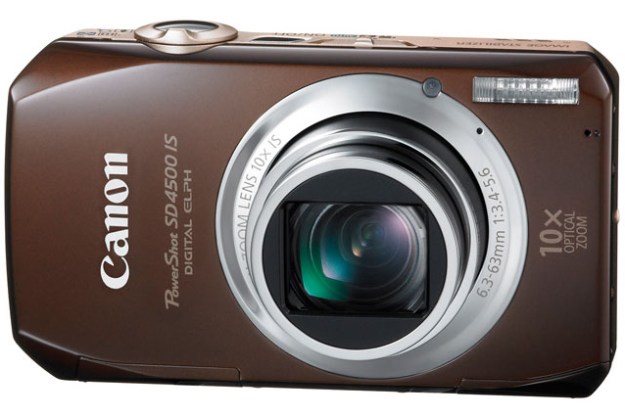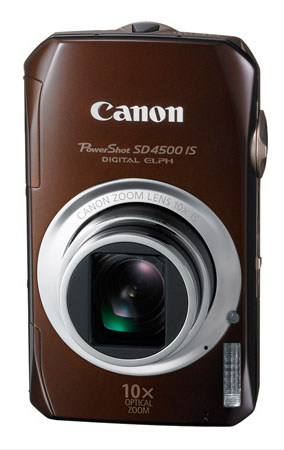
“Canon's SD4500 IS snaps crisp 10-megapixel stills and sharp 1080p HD video, if you can stomach the color and battery life.”
- 10x optical image stabilized lens
- 3-inch widescreen LCD
- very good optical image stabilizer
- low noise in dim light
- Body color is problematic
- very short battery life
- screen should be better
Introduction
Canon’s newest ELPH packs a 10x optical zoom into a compact 10-megapixel camera that also shoots full HD video. At first you’d think this is a winning combination. Let’s see if those initial impressions are on the money…
Features and design

If you can get past the color — and that’s a big if — this ELPH features a variation of the classic Canon “box and circle” design. In this case, it’s more a rectangle and circle, since the camera has an elongated shape to accommodate the 3-inch widescreen LCD screen on the back. The rear and bezels have a nice tan tone, but there are some issues here as well that we’ll get into shortly.
Within the “circle” on the front is a 10x optically stabilized zoom, double the range of other ELPHs, and an excellent feature for such a compact camera (0.9 inches thick, 6.7 ounces fully loaded). The lens has a solid focal range of 36-360mm, but we’d have preferred 28-280mm for a more pronounced wide-angle view. Also on the front is the flash, autofocus-assist lamp and pinhole mics to capture stereo sound.
The top of the camera is very simple, since this is a point-and-shoot with very few photographic tweaks. There’s a speaker, three-position mode switch, power button, and shutter button with surrounding zoom toggle. The three modes are Smart Auto, program auto and movie. Smart Auto, like Intelligent Auto on other cameras, picks the appropriate settings for the subject in front of it. The SD4500 IS has 28 options, far more than other models. It works really well as an aim-and-forget digicam. In the program (P) setting, you can change a few parameters such as white balance, metering, ISO (125-3200), exposure compensation and resolution. Since there’s no separate scene button, you’ll find those options when you tap the function/set key on the back while in P, using the scroll wheel to move through the choices. This is not very intuitive, but it’s not the end of the world. There are 19 scene modes at your fingertips. Most are typical, but there are a few that stand out, including Hand Held Night Scene and Low Light. In the Long Shutter mode, you can adjust shutter speed up to 15 seconds.
The rear of the camera highlights some other problems using a brown motif. To be color coordinated, the buttons on the right of the 3-inch, 230K-pixel widescreen LCD are also brown (see photo). That being the case, the red movie button on the top right fades into the background, and it’s hard reading the icons on the other buttons. The designers really fell down on the job with this baby. Along with the buttons, you’ll find a four-way controller surrounded by a scroll wheel. The points of the compass give access to the self-timer, flash and display options, as well as focus (macro, normal, infinity). Overall, the screen worked well, even in direct sunlight but it tended to smear in low light — typical for 230K-rated screens.

The right side has a compartment for USB and mini HDMI outs. On the bottom of the Made-in-Japan SD4500 IS is a compartment for SDHC/SDXC cards (Class 6 or better, please), a plastic tripod mount and a slot for the rechargeable battery. The battery is different than any other Canon power source, and is shaped like a Chapstick tube. This small battery is rated for only 150 shots—which means a spare is definitely in order if you plan to use the camera all day.
What’s in the box
The SD4500 IS comes bundled with USB and A/V cables, a wrist strap, and a 36-page Getting Started guide. The supplied CD-ROM has the full manual as a PDF, as well as software for handling files. There’s also that very different battery (NB-9L) and supplied charger. This battery has the least juice of any we’ve seen in a long time. It’s shockingly low, and a real negative.
Even with the unattractive color and “challenged” battery, it was time to put the Canon through its paces…
Performance and use
Beneath SD4500 IS’ exterior is not the proverbial hooker’s heart of gold, but a 10-megapixel backlit CMOS sensor. This new type of imaging device gives you quicker response, less digital noise at higher ISOs and HD video. Full still resolution is 3648 x 2736 pixels in JPEG format, and HD video is 1920 x 1080 at 24 fps, or 1280 x 720 at 30 fps, both in MOV format.
We had the camera for several weeks using it in a variety of locations, times of day, with people and without. Let’s put the body color in context — although personally you may not like it, no one is going to laugh or cringe at you as if you were Joaquin Phoenix. And once you get used to the poorly designated buttons, you find the camera easy to use, as you’d expect from a $300 Canon point-and-shoot. If you do buy this camera, a lens cloth should be in your pocket, as the LCD smudges rather easily. Now let’s get to the results.
HD video is one of the big claims to fame of this digicam so we couldn’t wait to watch them on our 50-inch plasma. As noted, we shot at both 1080p and 720p to see if there was a huge difference between full HD and not-so-full HD; there was. Colors shot in full HD were richer, and more accurate. Clips of trees moving in the fall breezes were far better at the top resolution, even with a slower frame rate. Definitely use this setting, and make sure you use a Class 6 or better card. We initially popped in a Class 4 SDHC card, and it stopped recording after about 30 seconds. The manual specifically states this, and after changing to a faster card, things moved easily. One plus is that fact you can use the 10x optical zoom while recording, and there’s not too much noise from the lens mechanism. On the down side, the two mics made gentle winds sound like Hurricane Katrina.
Still performance was very good, up to the usual Canon standards. Macro close-ups of one of the last flowers of the season were very sharp, even picking up a small insect we hadn’t seen while shooting. In Smart Auto and program, colors were really fine, with the 10-megapixel sensor capturing loads of fine detail. The 10x zoom is quite enjoyable, giving you a real spread of options. Images taken of steeples in Cambridge, Mass. near the Charles River were very sharp at full zoom, thanks in part to Canon’s OIS. Good stuff.
Another plus of backlit CMOS chips is the fact they materially increase a camera’s response time, and the tricks you can perform with that. The SD4500 IS grabs 3.7 frames per second at full resolution, which matches entry-level DSLR levels. Another winning feature is Hand Held Night Scene. Here the camera captures approximately 6 frames with one click of the shutter and combines them for a single image with less noise and more detail. Our test of a single candle in a dark room clearly showed this setting was better than the 2.5-megapixel Low Light option, or just using ISO 3200 in program. Noise in general was under control, and even an 8×10 print at 3200 was more than acceptable (in Low Light mode). Keep ISO at 800 or below at full resolution, and you’ll like the results.
Conclusion
The Canon PowerShot SD4500 IS is a solid-performing, compact 10x zoom camera, with some real pluses and negatives. Still and movie quality are top notch for a point-and-shoot, but then there’s the overall color scheme. Not to focus too much on the superficial, the camera’s menu is not very intuitive for certain settings, and the battery life is just plain underwhelming at 150 shots. If you can live with these issues, by all means pick it up. We’d rather spend our money elsewhere.
Highs:
- 10x optical image stabilized lens
- 3-inch widescreen LCD
- Very good optical image stabilizer
- Low noise in dim light
Lows:
- Body color is problematic
- Very short battery life
- Screen should be better




